Unveiling the twin epidemics of hypertension and diabetes: a cross-sectional analysis of sex-specific prevalence, risk, and hotspots in India's epidemiological transition zones
- PMID: 40349007
- PMCID: PMC12065286
- DOI: 10.1186/s12889-025-22983-y
Unveiling the twin epidemics of hypertension and diabetes: a cross-sectional analysis of sex-specific prevalence, risk, and hotspots in India's epidemiological transition zones
Abstract
Background: The prevalence of hypertension and diabetes, which often coexist and significantly contribute to the burden of noncommunicable diseases (NCDs), is increasing in India. This study examines the sex-stratified prevalence, coexistence, and bidirectional risks of hypertension and diabetes across states with varying epidemiological transition levels (ETLs) and identifies high-burden hotspots.
Methods: This study analysed data from the fifth round of the National Family Health Survey, covering 614,426 women and 556,199 men aged 30 years and above, with biomarker information on both diabetes and hypertension. The age-standardized prevalence was estimated, and adjusted risk ratios (ARRs) were obtained on multivariate logit scale. Bivariate maps, spatial autocorrelation and hotspot analyses were conducted using ArcGIS Pro to identify geographic clusters associated with twin epidemics.
Results: Individuals diagnosed with hypertension or diabetes were, on average, nearly a decade older than those without. Hypertension prevalence was 30.3% (95%CI:30.14-30.48) among men and 28.6% (95%CI:28.47-28.79) among women, whereas diabetes prevalence was at 19.7% (95%CI:19.58-19.88) in men and 17.4% (95%CI:17.22-17.50) in women. Among individuals with diabetes, 43.1% (95%CI:42.67-43.53) of men and 43.9% (95%CI:43.48-44.36) of women had hypertension, whereas 28.1% (95%CI:27.75-28.37) of hypertensive men and 26.6% (95%CI:26.33-26.93) of hypertensive women were diabetic. Hotspots for twin epidemics were identified in coastal regions, including the southern states with high ETLs, as well as the northern states with high-ETLs and the country's northeastern region. ARR estimates revealed that the risk of hypertension among individuals with diabetes was 39% higher (95%CI:1.38-1.40) in men and 41% higher (95%CI:1.39-1.42) in women than in individuals without diabetes. Similarly, the risk of diabetes among individuals with hypertension was 51% higher (95%CI:1.49-1.52) in men and 55% higher (95%CI:1.53-1.57) in women than in individuals without hypertension.
Conclusion: Our findings highlight the progressive nature of the twin epidemics of diabetes and hypertension, with an increased risk of onset associated with advanced age. The presence of one condition substantially elevates the likelihood of developing the other, highlighting their bidirectional relationship. Achieving Sustainable Development Goal target 3.4 requires addressing these intersecting epidemics as a unified entity for effective management. Targeted interventions should prioritise high-burden hotspots for integrated care strategies to mitigate the twin epidemics of diabetes and hypertension.
Keywords: Adjusted risk ratios; Diabetes; Epidemiological transition levels; Hotspots; Hypertension; Non-communicable diseases (NCDs); Twin epidemics.
© 2025. The Author(s).
Conflict of interest statement
Declarations. Ethics approval and consent to participate: Ethical approval for this study was not needed. The study used only anonymised data from secondary sources. All methods were carried out following relevant guidelines and regulations. Consent for publication: Not applicable. Competing interests: The authors declare no competing interests.
Figures

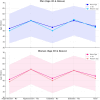
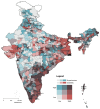
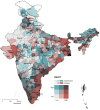
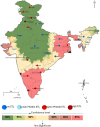
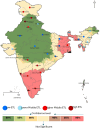
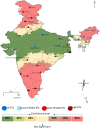

Similar articles
-
Care cascades of diabetes and hypertension among late adolescents in India.J Glob Health. 2025 Mar 7;15:04101. doi: 10.7189/jogh.15.04101. J Glob Health. 2025. PMID: 40048318 Free PMC article.
-
Sex differences in prevalence and risk factors of hypertension in India: Evidence from the National Family Health Survey-4.PLoS One. 2021 Apr 13;16(4):e0247956. doi: 10.1371/journal.pone.0247956. eCollection 2021. PLoS One. 2021. PMID: 33848291 Free PMC article.
-
Prevalence and risk factors for self-reported diabetes among adult men and women in India: findings from a national cross-sectional survey.Public Health Nutr. 2012 Jun;15(6):1065-77. doi: 10.1017/S1368980011002813. Epub 2011 Nov 4. Public Health Nutr. 2012. PMID: 22050916 Free PMC article.
-
Small Area Geographic Estimates of Cardiovascular Disease Risk Factors in India.JAMA Netw Open. 2023 Oct 2;6(10):e2337171. doi: 10.1001/jamanetworkopen.2023.37171. JAMA Netw Open. 2023. PMID: 37824144 Free PMC article.
-
Hypertension in India: a gender-based study of prevalence and associated risk factors.BMC Public Health. 2024 Oct 1;24(1):2681. doi: 10.1186/s12889-024-20097-5. BMC Public Health. 2024. PMID: 39354462 Free PMC article.
References
-
- Global Health Metrics. (2019) non-communicable-diseases. Lancet 396. https://www.thelancet.com/pb-assets/Lancet/gbd/summaries/diseases/non-co...
-
- WHO. (2024) Noncommunicable diseases. https://www.who.int/health-topics/noncommunicable-diseases#tab=tab_1. Accessed 1 Apr 2025.
-
- Mamgai A, Halder P, Behera A, Goel K, Pal S, Amudhamozhi KS, Sharma D, Kiran T. Cardiovascular risk assessment using non-laboratory based WHO CVD risk prediction chart with respect to hypertension status among older Indian adults: insights from nationally representative survey. Front Public Health. 2024. 10.3389/fpubh.2024.1407918. - PMC - PubMed
-
- Halder P, Jeer G, Nongkynrih B. Risk assessment of type 2 diabetes mellitus using Indian diabetes risk score among females aged 30 years and above in urban Delhi. Indian J Med Sci. 2023;75:136–43.
MeSH terms
LinkOut - more resources
Full Text Sources
Medical

